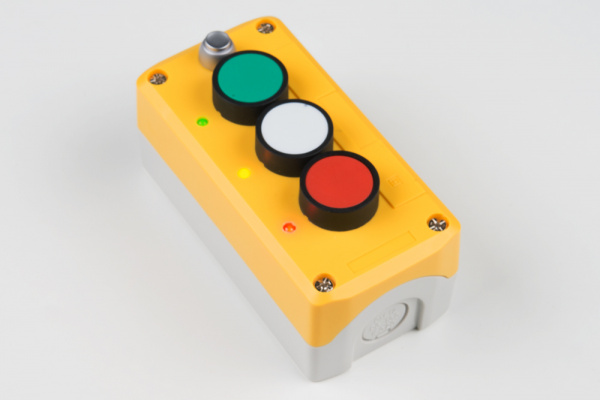How to Build a Remote Kill Switch
Remote Control Unit
The RCU is the thing that the user holds in their hand and jams the red button in case the autonomous vehicle becomes sentient, or is just doing something it shouldn’t.
Let’s start with the simple bits: The LEDs are simply on/off and don’t need PWM pins. I chose to connect the LEDs to pins 3, 4, and 5 because it allowed me to solder in a 3-pin JST connector. The three buttons within the switch station are the Normally Open (NO) type. I wired them to pins 6, 7 and 9 with 8 serving as the ground pin. I did this because I ran out of GND pins on the Pro Mini. You can use a GPIO as ground, you just set it as an output and LOW. Also, by creating a bank of four pins it allowed me to solder a 4-pin JST directly to the Pro Mini.
The RFM69 is wired according to Mike’s excellent hookup guide. Note: The connection from pin 2 on the Pro Mini to DIO0 on the RFM69 is required and serves as the interrupt from RFM to Pro Mini. You cannot use a different pin on the Pro Mini because pin 2 is a hardware interrupt pin, and the library depends on interrupts.
The remote needs to have a battery! I used the 3.7V 850mA LiPo. The average current draw is about 42mA, so this should last for around 20 hours on a charge. I didn’t do any power minimization efforts because 20 hours was plenty for my purposes. To avoid having to open and close the enclosure to charge the battery, I installed a LiPo charger with miniB connector. Plugging a miniB cable in will charge the battery any time, and pressing S4 (a latching switch) will turn on/off the remote. Note that if the remote is turned off, the vehicle will go into automatic safety shutdown (a good thing).
I really enjoy the quality and feel of the three buttons in the Switch Station, but they are very big and packing all the electronics into the enclosure is a challenge. If I were to build another remote, I would look for a better trade off of more room vs quality (there are many low quality switch stations on Amazon with more room inside the enclosure).

